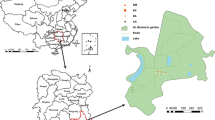Abstract
Alfresco (def. clean, outdoor) airborne bacteria were collected with a commercially available wet-cyclone bioaerosol sampler to demonstrate its use, sample processing and resultant observations of total and culturable bacteria in mid-summer in the mid-Willamette River Valley, OR. Some critiques of the system are given. The maximum and minimum total and culturable airborne bacterial concentrations in the samples were 5.9 × 105 and 8.8 × 102 cells m−3, and 1.3 × 104 and 3.1 CFU m−3, respectively. What is thought to be a diurnal cycle was also observed for both fractions with highest concentrations during the day and lowest at dawn and dusk. The culturable bacteria as a percentage of the total, was maximal at mid-day (≈ 3%) and minimal at early morning and late evening (≈ 0.5–2%). Contrarily, the total bacteria in the downwind dust plume of a grass seed combine was 2.9 × 106 cells m−3 and of these approximately 73% were culturable, a much greater culturable percentage than found in the alfresco outdoor atmosphere.
Similar content being viewed by others
References
Aker TG. Some aspects of the airborne inactivation of viruses. In: Hers JFPh, Winkler KC, editors. Airborne Transmission and Airborne Infection. Utrecht: Oosthoek, 1973:73–81.
Buchanan LM, Harstad JB, Phillips JC, Lafferty E, Dahlgren CM, Decker HM. Simple liquid scrubber for large volume air sampling. Appl Microbiol 1972;23:1140–4.
Choi JW, Sherr EB, Sherr BF. Relation between presence/absence of visible nucleoid and metabolical activity in bacterioplankton cells. Limnol Ocean 1998 (in press).
Cox CS. The Aerobiological Pathway of Microorganisms. New York: Wiley, 1987:293.
Cox CS, Wathes CM, editors. Bioaerosols Handbook. Boca Raton, FL: Lewis Publishers, CRC Press, 1995.
Decker HM, Buchanan LM, Frisque DE. Advances in large-volume air sampling. Contam Control 1969;8:13–7.
Errington FP, Powell EO. A cyclone separator for aerosol sampling in the field. J Hyg Camb 1969;67:387–99.
Fedorak PM, Westlake DWS. Effect of sunlight on bacterial survival in transparent air samplers. Can J Microbiol 1978;24:618–9.
Griffiths WD, Boysan F. Computational fluid dynamics (CFD) and empirical modelling of the performance of a number of cyclone samplers. J Aerosol Sci 1996;27(2):281–304.
Griffiths WD, DeCosemo GAL. The assessment of bioaerosols: a critical review. J Aerosol Sci 1994;25(8):1425–58.
Griffiths WD, Stewart IW, Reading AR, Futter SJ. Effect of aerosolization, growth phase and residence time in spray and collection fluids on the culturability of cells and spores. J Aerosol Sci 1996;27(50):803–20.
Griffiths WD, Stewart IW, Fuller SJ, Upton SL, Mark D. The development of sampling methods for the assessment of indoor bioaerosols. J Aerosol Sci 1997;28(3):437–57.
Hobbie JE, Dalley RJ, Jasper S. Use of nucleopore filters for counting bacteria by fluorescence microscopy. Appl Environ Microbiol 1977;35(5):1225–8.
Jensen PA, Todd WF, Davis GN, Scarpino PV. Evaluation of eight bioaerosol samplers challenged with aerosols of free bacteria. Am Ind Hyg Assoc J 1992;53(10):660–7.
Kaprelyants AS, Kell DB. Dormancy in stationary-phase cultures ofMicrococcus luteus: flow cytometric analysis of starvation and resuscitation. Appl Environ Microbiol 1993;59(11):3187–96.
Lighthart B, Mohr AJ. Estimating downwind concentrations of viable airborne microorganisms in dynamic atmospheric conditions. Appl Environ Microbiol 1987;53(7):1580–3.
Lighthart B, Mohr AJ, editors. Atmospheric Microbial Aerosols. New York: Chapman and Hall, 1994:397.
Lighthart B, Shaffer BT. Bacterial flux from chaparral into the atmosphere in mid-summer at a high desert location. Atmos Environ 1994;28(7):1267–74.
Lighthart B, Shaffer BT. Airborne bacteria in the atmospheric surface layer: temporal distribution above a grass seed field. Appl Environ Microbiol 1995;61(4):1492–6.
Lighthart B, Shaffer BT. Increased airborne bacterial survival is also a function of particle size and composition. Aerosol Sci Technol 1997;27:439–46.
Lin X, Willeke K, Ulevicius V, Grinshpun SA. Effect of sampling time on the collection efficiency of all-glass impingers. Am Ind Hyg Assoc J 1997;58:480–8.
Neff WD, King CW. Observations of complex-terrain flows using acoustic sounders: experiments, topography and winds. Boundary-Layer Meteorol 1987;40:363–92.
Terzieva S, Donnelly J, Ulevicius J, Grinshpun SA, Willeke K, Stelma GN, Brenner P. Comparison of methods for detection and enumeration of airborne microorganisms collected by liquid impingement. Appl Environ Microbiol 1996;62(7):2264–2272.
Schroeder MJ, Fosberg MA, Cramer OP, O’Dell CA. Marine air invasion of the Pacific Coast: a problem analysis. Bull Am Meterol Soc 1967;48:802–8.
Tong Y, Lighthart B. Solar radiation has a lethal effect on natural populations of culturable outdoor atmospheric bacteria. Atmos Environ 1997;31(6):897–900.
Upton SL, Mark D, Hall EJ, Griffiths WD. A wind tunnel evaluation of the physical sampling efficiencies of three bioaerosol samplers. J Aerosol Sci 1994;25(8):1493–501.
Vincent JH. Aerosol Sampling — Science and Practice. New York: Wiley, 1989;390.
Author information
Authors and Affiliations
Corresponding author
Rights and permissions
About this article
Cite this article
Lighthart, B., Tong, Y. Measurements of total and culturable bacteria in the alfresco atmosphere using a wet-cyclone sampler. Aerobiologia 14, 325–332 (1998). https://doi.org/10.1007/BF02694301
Received:
Accepted:
Issue Date:
DOI: https://doi.org/10.1007/BF02694301




